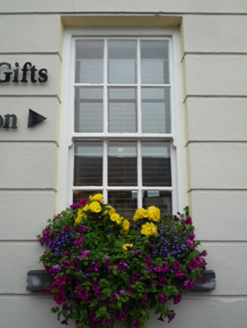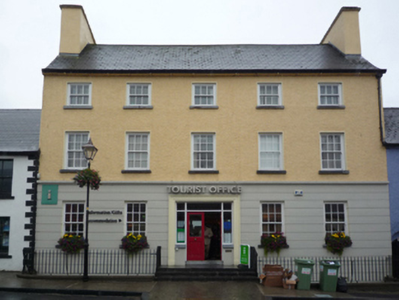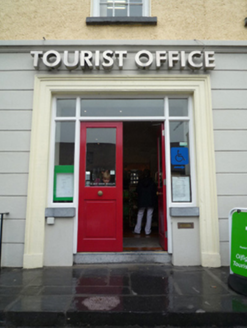Survey Data
Reg No
31212076
Rating
Regional
Categories of Special Interest
Architectural, Artistic, Historical, Social
Previous Name
Westport Garda Síochána Station
Original Use
House
Historical Use
Garda station/constabulary barracks
In Use As
Office
Date
1787 - 1838
Coordinates
99649, 284466
Date Recorded
18/08/2008
Date Updated
--/--/--
Description
Terraced five-bay two-storey over part raised basement townhouse, extant 1838, on a rectangular plan. Occupied, 1901; 1911. Sold, 1921, to accommodate alternative use. "Repaired", 1930. Closed, 1989. "Restored", ----, to accommodate alternative use. Replacement pitched artificial slate roof with clay ridge tiles, cement rendered chimney stacks having stepped capping, and uPVC rainwater goods on rendered cut-limestone eaves retaining cast-iron hopper and downpipe. Rendered channelled wall (ground floor) with moulded rendered stringcourse; roughcast surface finish (upper floors); rendered surface finish (remainder). Remodelled hipped square-headed central door opening approached by platform of three tooled cut-limestone steps with timber mullions on tooled cut-limestone step threshold supporting timber transom, and moulded rendered surround framing glazed timber panelled double doors having sidelights below overlight. Square-headed window openings (ground floor) with drag edged dragged cut-limestone sills, and concealed dressings framing replacement six-over-six timber sash windows. Square-headed window openings (upper floors) with drag edged dragged cut-limestone sills, and concealed dressings framing replacement six-over-six (first floor) or three-over-three (top floor) timber sash windows. Street fronted with wrought iron railings to perimeter.
Appraisal
A townhouse representing an important component of the domestic built heritage of Westport with the architectural value of the composition confirmed by such attributes as the compact rectilinear plan form centred on a restrained doorcase; the diminishing in scale of the openings on each floor producing a graduated visual impression; and the high pitched roof. Having been well maintained, the form and massing survive intact together with quantities of the original or replicated fabric, both to the exterior and to the interior, thus upholding the character or integrity of a townhouse temporarily occupied (1846-9) by George John Browne (1820-96), third Marquess of Sligo, on the closure of Westport House at the height of the Great Famine (1845-9). NOTE: Occupied (1901; 1911) by Thomas Allman (1848-1915), 'Medical Doctor [and] Physician [and] Surgeon' (NA 1901; NA 1911).





